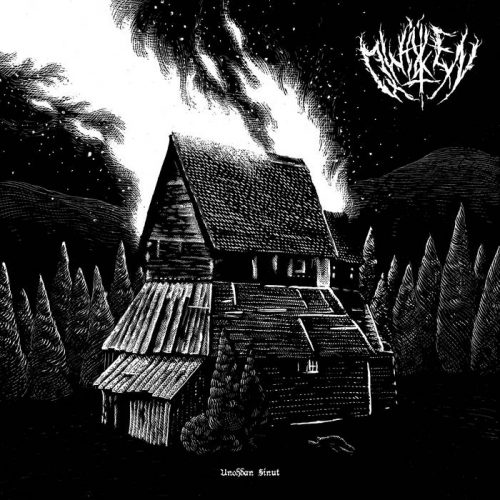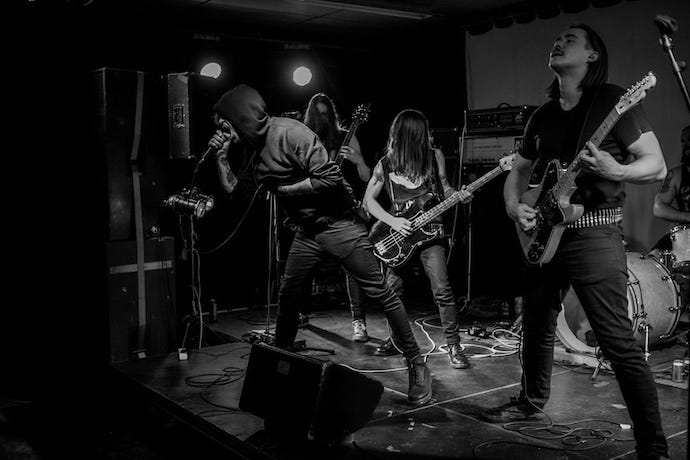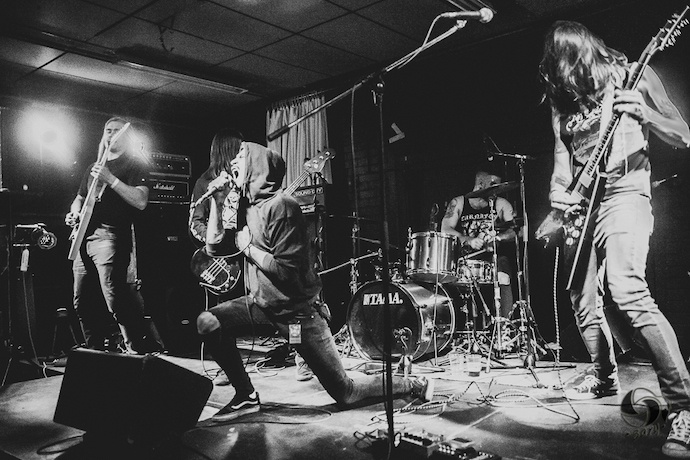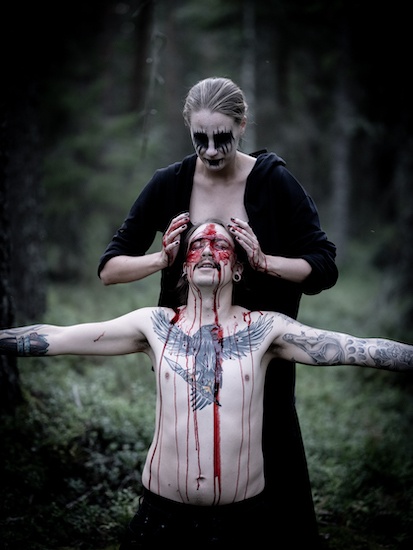
Musicologists have spilled millions of words tracing the twisting and twining path of underground and popular music from R&B to rock ‘n’ roll, punk, metal, and elsewhere. Over time, and in different ways, the connections often seem to snap apart, producing music that seems severed from distant roots, even as the overaching ethos of “outsider” music might remain intact. Blast-beats, for example, diverge sharply from back-beats and d-beats, and the blazing or freezing aggression of tremolo’d riffing seems alien to head-nodding three-chord progressions, just as incomprehensible screaming veers dramatically from a voice that carries a melody.
But even with regard to black metal (perhaps the paragon of severed connections such as those mentioned above), punk was deep down in its early roots, and it’s still alive and well in the music of some segments of black metal who are kicking up sonic storms in the here-and-now. The music of the Finnish quintet Qwälen is one such example, as reveled on their debut album Unohdan Sinut, which is set for release by Time To Kill Records on February 19th, and which we’re premiering in full right now.

But we hasten to add that while you can clearly discern the influence in Qwälen’s music of such bands as Young and in the Way and Dödsrit, their self-professed inspirations also include the likes of Darkthrone, Nifelheim, Bathory, and Terveet Kädet.
Speed and fury are among the hallmarks of the music. Throughout the album the band don’t take their foot off the pedal very often — the songs fly like bats out of hell — but the drum rhythms nevertheless change frequently, commingling both blast-beats and punk cadences, both piston-like hammering and hard-rocking rhythms. The riffing changes as well. Though the rapidly vibrating chords usually blaze like wildfire, the band pick their moments to clang and slash. There’s not much variation in the vocal department, but the larynx-lacerating screams can be relied upon to help keep the music’s intensity way up in the red zone.
But perhaps what stands out most of all, as perhaps the leading hallmark of these songs, are the gripping harmonies created by the feverish dual-guitar leads. They not only vibrantly channel a range of dark and disturbing emotions, they also burrow into the listener’s head with relentless penetrating force, their relative clarity piercing through the raw and ravaging tones of what surrounds them.

The album opener “Pimeä tila’ quickly reveals all these signal ingredients. It launches with hammering drums and a dense squall of cold, vicious riffing, rapidly quivering leads, and throat-tearing shrieks, but switches into bounding punk cadences, thudding bass tones, and heaving, hammering chords. But even there, the flickering leads create piercing harmonies, which in this case sound poisonous and demented. When the drums relent even further or disappear altogether, the melodies become eerie to the point of fashioning perilous audio hallucinations, and as the blasting resumes, the music blares, and even seems to soar, in cruel exultation.
Elsewhere on the album the music creates palpable tension and turbulence, and flares into unhinged mania. On the other hand, “Hän ei tule koskaan” might the most hard-rocking track. Opening with a deep, banging bass riff, it incorporates scampering punk beats and head-moving back-beats, as well as cold, rocking guitar riffs and incinerating doubled screams. It’s a bleak and bruising experience, but accented with buzzing dual-guitar leads that rise like bonfire flames, and in doing so convert the song into an anthem of pain and perseverance.
The title track, “Unohdan sinut”, surges in a torrent of blasting with super-heated riffing that seems to channel both misery and mayhem, but includes some hard-slugging grooves and clanging chords interspersed in the midst of the jet-fueled momentum (and it might be the song most reminiscent of Young and in the Way), while the closer “Temppeli” spins with ebullience but also bores like a diamond drill-bit biting through metal, and the melody also becomes moody and almost introspective over rocking beats and big magma-like bass tones.

While we call out just these few tracks to demonstrate the album’s relative variations, there really aren’t any weak links in this album chain. You could pick any one of them at random and get a big rush. Nevertheless, as electrifying as the music is, you’ll never mistake these as happy sounds. Lyrically, the songs eschew the usual anti-religious black metal themes and focus instead on self-portrayals. The band write:
“What is left when you lose something dear to you? The world appears as a dark dystopian wasteland, with no one left to offer anything even close to comfort. Self-pity, misanthropy, Satan and abandonment offer new alternatives. Where can one turn his or her gaze to eventually forget and rebuild?
“Now I can burn my temple. Destroy everything I created. Draw the plans into its ashes and start anew.”
All instrumentation on the album was recorded completely live in the Finnish countryside with Tom Brooke over two days. Vocals were recorded by Otto Joki. The band advise that “minimal corrections were done as the focus was to capture the band in a very raw state”. Tom Brooke also mixed and mastered the record, and the cover art and layout were done by Jussi Phojanen.
Time To Kill Records will release the album on limited edition vinyl and digital formats.
PRE-ORDER:
https://qwaelen.bandcamp.com/album/unohdan-sinut
https://timetokillrecords.bigcartel.com/category/qwalen
QWÄLEN:
https://www.facebook.com/qwalen
https://www.instagram.com/qwaelen/

Didnt know the band, amazing album